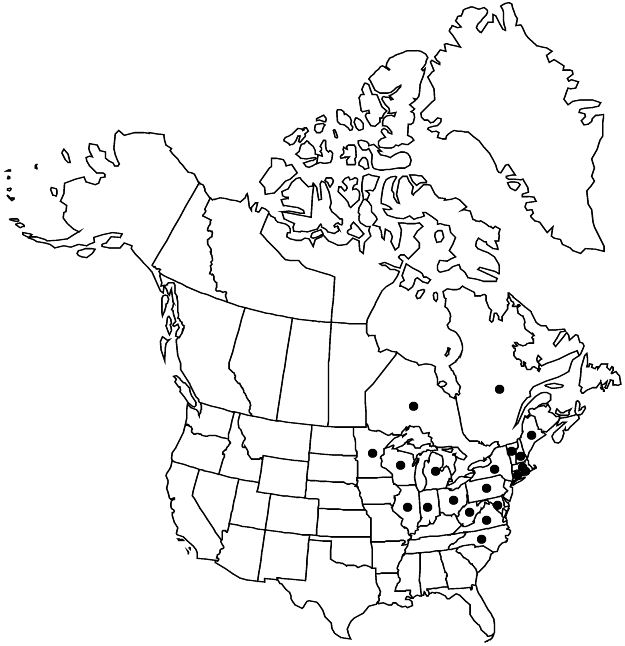Difference between revisions of "Crataegus coccinea"
Sp. Pl. 1: 476. 1753.
FNA>Volume Importer |
imported>Volume Importer |
||
| Line 23: | Line 23: | ||
-->{{Treatment/Body | -->{{Treatment/Body | ||
| − | |distribution= | + | |distribution=Ont.;Que.;Conn.;Ill.;Ind.;Maine;Mass.;Md.;Mich.;Minn.;N.C.;N.H.;N.Y.;Ohio;Pa.;R.I.;Va.;Vt.;W.Va.;Wis.;introduced in Europe. |
|discussion=<p>Varieties 3 (3 in the flora).</p><!-- | |discussion=<p>Varieties 3 (3 in the flora).</p><!-- | ||
--><p><i>Crataegus coccinea</i> is found from extreme southeastern Minnesota, Wisconsin, and Illinois through the southern Great Lakes area to coastal Maine, and in the Appalachians at higher altitudes to North Carolina; it is common in the north of its range.</p><!-- | --><p><i>Crataegus coccinea</i> is found from extreme southeastern Minnesota, Wisconsin, and Illinois through the southern Great Lakes area to coastal Maine, and in the Appalachians at higher altitudes to North Carolina; it is common in the north of its range.</p><!-- | ||
| Line 63: | Line 63: | ||
|basionyms= | |basionyms= | ||
|family=Rosaceae | |family=Rosaceae | ||
| − | |distribution= | + | |distribution=Ont.;Que.;Conn.;Ill.;Ind.;Maine;Mass.;Md.;Mich.;Minn.;N.C.;N.H.;N.Y.;Ohio;Pa.;R.I.;Va.;Vt.;W.Va.;Wis.;introduced in Europe. |
|reference=None | |reference=None | ||
|publication title=Sp. Pl. | |publication title=Sp. Pl. | ||
|publication year=1753 | |publication year=1753 | ||
|special status=Endemic | |special status=Endemic | ||
| − | |source xml=https:// | + | |source xml=https://bibilujan@bitbucket.org/aafc-mbb/fna-data-curation.git/src/bb6b7e3a7de7d3b7888a1ad48c7fd8f5c722d8d6/coarse_grained_fna_xml/V9/V9_946.xml |
|subfamily=Rosaceae subfam. Amygdaloideae | |subfamily=Rosaceae subfam. Amygdaloideae | ||
|tribe=Rosaceae tribe Gillenieae | |tribe=Rosaceae tribe Gillenieae | ||
Revision as of 00:34, 28 May 2020
Shrubs or trees, 70–80(–120) dm. Stems: twigs: new growth greenish, glabrous or slightly hairy; thorns on twigs straight to recurved, ± stout, 2–4 cm. Leaves: petiole length 30–40% blade, glabrate to densely hairy, glandular or eglandular; blade ovate or broadly elliptic to elliptic-ovate, (4–)5–8 cm, base broadly cuneate to subtruncate, rarely slightly cordate, lobe apex acute, margins serrate, sometimes doubly serrate, teeth 2 mm, adaxial surface usually densely scabrous young. Inflorescences: branches sparsely to densely pubescent. Flowers: hypanthium glabrous or densely pubescent; stamens (5–)8–10(–20), anthers pink to rose-purple. Pomes usually bright red, suborbicular to oblong, 10–14 mm, often sparsely pubescent (especially at ends); sepals spreading or missing.
Distribution

Ont., Que., Conn., Ill., Ind., Maine, Mass., Md., Mich., Minn., N.C., N.H., N.Y., Ohio, Pa., R.I., Va., Vt., W.Va., Wis., introduced in Europe.
Discussion
Varieties 3 (3 in the flora).
Crataegus coccinea is found from extreme southeastern Minnesota, Wisconsin, and Illinois through the southern Great Lakes area to coastal Maine, and in the Appalachians at higher altitudes to North Carolina; it is common in the north of its range.
Crataegus coccinea varies in leaf shape and planeness and in fruit shape. In some areas, more or less pure populations of the different variants occur. It is easiest to group the variation around two relatively strongly marked varieties with ten or fewer stamens, vars. coccinea and pringlei, between which intermediates are common, and the 20-stamen var. fulleriana.
Selected References
None.
Lower Taxa
Key
| 1 | Leaf blades (elongate), ovate (length/width = 1.4–1.5), 5–8 cm (widest in proximal 1/3), plane, lobe sinuses deep, bases broadly cuneate to truncate, rarely slightly cordate; pomes usually suborbicular. | Crataegus coccinea var. coccinea |
| 1 | Leaf blades broadly elliptic to elliptic-ovate (length/width = 1.2), 4–7 cm, plane or concavo-convex, lobe sinuses often shallow, bases rounded to broadly cuneate; pomes usually oblong or suborbicular | > 2 |
| 2 | Stamens 8–10; leaf blades conspicuously concavo-convex; pomes usually oblong. | Crataegus coccinea var. pringlei |
| 2 | Stamens 20; leaf blades usually plane, rarely concavo-convex; pomes usually suborbicular. | Crataegus coccinea var. fulleriana |